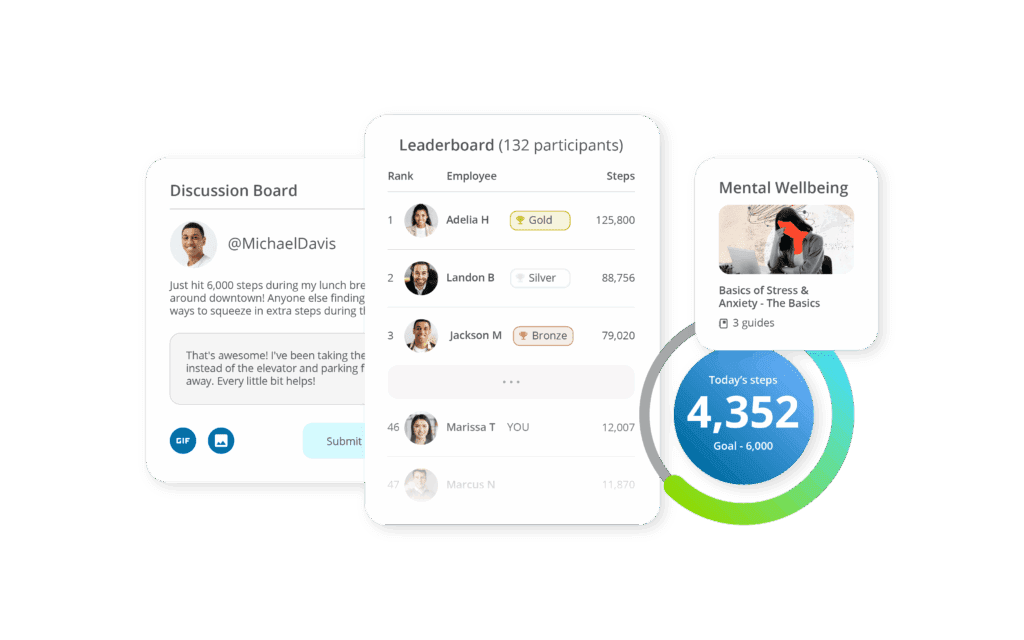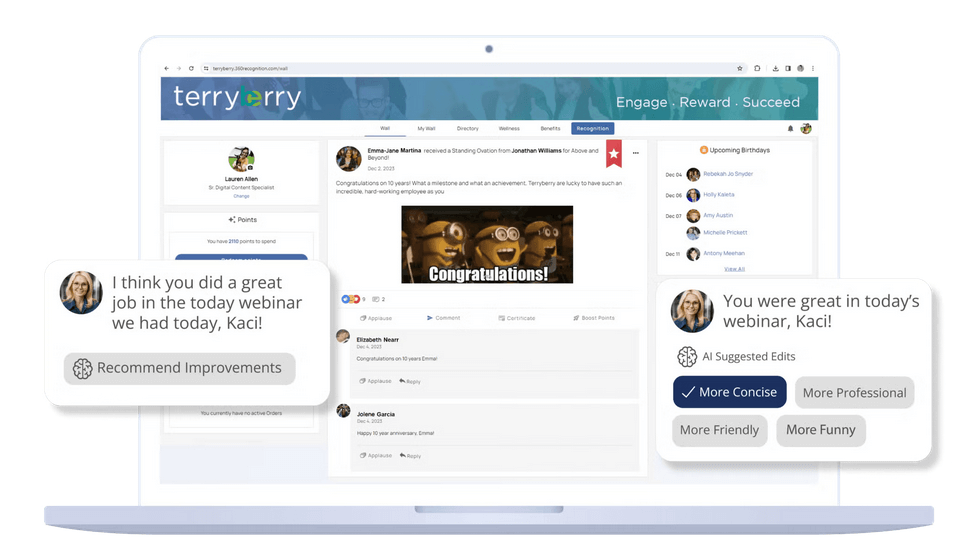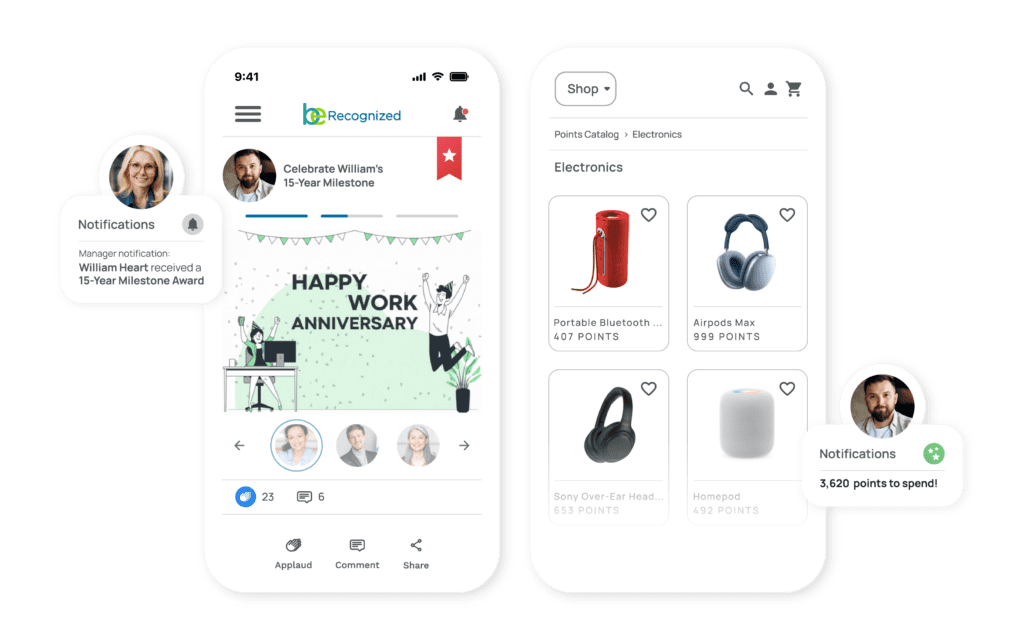September 25, 2025

Employee retention has always been a hot topic in the world of human resources. It’s no secret that employee turnover can be costly for businesses - both in terms of money and lost productivity.
It’s estimated that each lost employee equates to a cost of 1.5 to 2 times that employee’s annual salary. Not to mention, it can take a business up to six months to replace them. High turnover can also negatively impact business performance and customer relationships, as losing valuable employees disrupts team dynamics and can erode trust with clients.
Additionally, according to Gallup’s State of the Global Workplace Report, only 33% of employees across the world are engaged in the workplace. Without engagement, retention becomes even more of a challenge. Low engagement can lead to lower retention rates, which in turn hinders organizational success by making it harder to align goals and maintain a strong company culture.
Learning how engagement and retention affect each other could help organizations find long-term solutions for decreasing turnover and building improved company cultures, resulting in more satisfied employees and better business outcomes.
Key Takeaways
- Strong Relationships Matter: Build connections between employees and managers, and colleagues for higher engagement and retention.
- Invest in Growth: Offer training and development opportunities to keep employees challenged and valued, reducing turnover.
- Measure & Adapt: Track engagement and retention metrics to identify areas for improvement and refine your engagement strategy for better employee-centric outcomes.
Why Does Employee Engagement and Retention Matter?
The bottom line is that poor employee retention is an expensive problem for organizations. Employee turnover causes lost profitability and productivity, more costly recruitment, the loss of quality candidates, time spent training, and significant training costs associated with replacing employees.
This can cause a domino effect as well. Companies end up having to allocate resources to those issues instead of providing raises, bonuses, etc. Additionally, high turnover affects engagement, company culture, and the employee experience. High turnover can also disrupt teams and make it harder to retain and support existing employees.
But when companies get it right, they can experience:
Improved Employee Experience
The employee experience involves each stage of the employee life cycle, from recruitment to retirement. A strong employee value proposition enhances the employee experience by clearly communicating the rewards, recognition, and opportunities a company offers, which supports retention and aligns with employee expectations. With retention strategies in place, organizations can focus on improving the employee experience in a meaningful way.
More Experienced Employees
With high turnover, the likelihood of having experienced employees who understand the organization and champion its mission is low.
Conversely, employees who do stay with a company long term naturally gain a deeper knowledge of the company itself and its offerings. Retaining high performing employees is essential for maintaining organizational knowledge and driving results. These employees are invaluable and contribute more to the bottom line.
Stronger Work Relationships
Employees who spend a lot of time together are more likely to collaborate better, support each other, and build strong relationships. Engagement increases when teams care about each other’s successes. This also helps to build a strong, resilient, and collaborative company culture, where strong relationships foster mutual respect among team members.
Increased Profitability and Time
Organizations save time and money by not having to consistently onboard and offboard employees. Effective talent retention strategies contribute to long-term profitability and organizational stability by reducing turnover and maintaining a skilled workforce.
Moreover, when employees are invested in their work and the company, they’re more likely to work harder for the company (and stay). This leads to higher profitability and increased employee engagement.
Impacts of Effective Employee Engagement

How Engagement Impacts Performance
Countless studies have found a correlation between engaged employees and higher-performing companies.
A study by Gallup found that companies with more engaged workforces have higher earnings per share. This study also found that companies with more engaged workforces tended to recover from the 2008 recession at a faster rate, as well.
Another Gallup report on employee engagement shows that companies with a highly engaged workforce have 21% higher profitability. Conversely, these companies also have 17% higher productivity than those with a disengaged workforce.
Implementing strategies for boosting employee engagement, such as leveraging technology and recognition programs, can significantly enhance internal communication and overall engagement within the organization. When engagement initiatives are effectively implemented, they can positively influence the entire organization, impacting all departments and levels—not just individual teams.
It’s also estimated that companies in the U.S. lose between $450-$550 billion each year due to disengaged workers.
How Engagement Impacts Retention
Employee engagement is one of the strongest predictors of employee turnover. Engaged employees are connected to the company’s mission – they believe their work has meaning and purpose. These employees are also more likely to be connected to the company’s culture and values.
Tailored employee engagement initiatives, which include setting goals, involving people, and measuring success, can significantly improve retention by making employees feel valued and satisfied.
So much so, it’s estimated that highly engaged employees are 87% less likely to quit. Increasing your employee engagement share—the proportion of employees who are truly engaged—can significantly reduce turnover and boost overall workplace satisfaction. Conversely, disengaged and actively disengaged employees always have one foot already out the door. And unfortunately, it’s estimated that 68% of employees are either disengaged or actively disengaged.
It’s clear to see how engaging employees can improve retention. But because employee engagement is impacted by all aspects of the employee experience, it’s not always a simple area to improve.
What Can Hurt Employee Engagement and Retention?
As we know, employees who are engaged are more likely to stay with their organization rather than search for a different job opportunity. However, negative employee perceptions of the workplace—such as feeling unheard or lacking trust in leadership—can significantly contribute to disengagement and higher turnover. But what causes employees to disengage in the first place?
Poor Communication
Employees who feel out of the loop or like they aren’t being included in important conversations are likely to start feeling disengaged. Communication is key in any business, and it’s important to make sure all employees feel like they can easily connect with their colleagues and voice their opinions. Prioritizing transparent communication helps build trust and engagement throughout the organization.
Lack of Connection to the Company Mission
Engaged employees feel like their work matters and that it contributes to a greater goal. If your employees don’t understand how their individual roles fit with the overall company values, you’ll risk employee satisfaction and engagement.
Reinforcing the company's culture helps employees connect more deeply with the mission and understand how their contributions support the organization’s purpose. So, make sure you regularly remind your employees of the company values and why their work is so important to the company’s mission.
No Recognition or Appreciation
Everyone needs to feel appreciated for the work they do, no matter how small it may be. When employees don’t receive recognition for their efforts, they’re likely to become disengaged employees. Recognizing employees for their hard work and dedication is key to creating a positive workplace environment.
No Career Development Opportunities
Many employees want to feel like they're growing in their roles and that there are opportunities for them to advance their skills. In fact, Pew research found that 63% of people who quit their jobs in 2022 did so due to a lack of career advancement opportunities. Providing growth opportunities is essential for keeping employees motivated and invested in their long-term success.
If your employees don’t have access to training or professional development opportunities, it may be difficult for them to continue to feel engaged in their work. Supporting both career growth and personal growth can significantly increase employee engagement and retention.
No Feedback
Similar to career development, employee feedback is essential for maintaining engagement and fostering communication between employees and the organization.
If employees don’t receive regular feedback on their performance, they’ll have no way of knowing what skills they should be striving to develop and which ones are their strengths. This can naturally lead to feelings of apathy and disengagement.
Instead, make sure you’re providing your employees with regular performance reviews and constructive feedback so that they can continue to grow and develop in their roles.
Lack of Flexibility
As we continue to shift to a world where remote work is the new norm, giving flexibility to your team members is key. With as much as 62% of workers) believing that remote work positively affects their work engagement, it’s important to, whenever possible, give your employees the freedom to work in a way that best suits them.
Offering flexibility is especially important for remote employees, as it helps them stay engaged and connected despite the unique challenges of working outside a traditional office.
How to Make Employee Retention and Engagement Successful

Successful employee engagement programs require adequate groundwork. In order to determine if your organization is facing employee engagement and retention issues, research needs to be done.
Effective employee retention strategies not only foster cohesive team dynamics but also contribute to innovative problem-solving and the nurturing of a leadership pipeline within the organization.
Organizations need to understand why employees leave in the first place. Once you know the extent of your engagement and retention problem, your organization can execute ways to solve it.
- Research. Turnover analysis can be done through (external and internal), pulse surveys, attending SHRM conferences and performing competitor analysis. Additionally, using engagement surveys and employee surveys helps gather feedback and identify several key factors affecting retention.
- Create an action plan. After conducting research, it’s time to make a plan that will improve your retention. The use of broad strategies (company culture, salaries, etc.) and targeted strategies (exit interviews, stay interviews, and focus groups) will help create a comprehensive action plan, incorporating employee suggestions to address specific needs.
- Implementation. You’ve laid the groundwork, now it’s time to execute strategies that were identified by your organization.
- Evaluate results. After implementing your plan, you should be evaluating (quarterly, bi-annually, or annually) the results to assess the impact your strategies are having and adjust accordingly. Tracking engagement metrics will help measure progress in improving retention.
8 Tips to Improve Employee Retention and Engagement
While you won’t see dramatic improvement overnight, it’s important to be consistent. Consistent engagement efforts are essential to achieve lasting results and foster a positive workplace environment.
Building a healthy company culture takes time. In the meantime, be mindful of best practices that focus on the “human” aspect.
1. Appreciation and Recognition
According to Gallup's Transforming Workplaces Through Recognition report, more than 70% of workers with excellent recognition at work "rate their lives more positively overall and are more likely to be thriving in their everyday lives compared to those who aren't being fully recognized."
Peer recognition comes in many different forms - quick comments of appreciation, thank you notes, or email shout-outs, to name a few.
There’s no one right way to recognize employees, but there are ways to streamline and simplify the process. Virtual employee recognition platforms offer an approach everyone can appreciate.
Instead of asking HR representatives to piece together a program, an all-in-one platform establishes a framework and rewards system that allows for consistent employee recognition, with everything in one place. Terryberry’s Social Recognition Platform and Program is designed for both peer recognition and manger-led recognition.
A recognition platform also makes it much easier for you to analyze the metrics related to your program. This can help inform future decisions about the program.
2. Freedom of Flexibility
Flexible work arrangements benefit both employers and employees. It allows workers to balance work and personal life, which can make them more productive. For employers, it means retaining their best employees for longer.
3. Work-Life Balance
If you create an environment where employees feel valued and respected, it significantly enhances employee satisfaction and retention within your organization. Everyone wants to feel like they’re seen as more than just an employee. Encouraging your team to have fulfilling lives outside of work will help achieve this.
4. Competitive Pay
While pay isn’t the only factor when it comes to employee engagement and retention, it’s undeniable that it matters. Offering competitive compensation is crucial for attracting and retaining top talent, as it ensures your salaries and benefits meet or exceed market standards.
Simply put - you’re employees will be open to other opportunities if they’re not paid well. If your employees feel they’re underpaid, they’re likely to be less engaged or even actively disengaged from work, as well.
5. Business and Personal Alignment
At the same time, employees want more than just money—they also need a sense of meaning at work. Ask your employees what they want their jobs to be about. Then, align it with the organization’s interests.
Aligning roles with opportunities for professional growth can also increase engagement, as employees are more likely to be motivated when they see clear paths for skill development and career advancement.
6. Feedback
Use quick, real-time pulse surveys to collect honest employee feedback data quickly. You can send these employee surveys out on a regular cadence (weekly, monthly, quarterly) or use them one-off to problem-solve or identify growing issues before they become full-scale challenges. Employee journey mapping can help track and analyze feedback throughout various stages of the employee lifecycle.
While one-time surveys can reveal powerful insights, gathering feedback regularly is an essential starting point for improving employee engagement and performance management. Regular surveys help gather insights that are crucial for understanding employee sentiment and addressing workplace issues in real-time.
It’s even better when you compare surveys over time to discover trends. Is your workforce becoming more or less engaged? Are they comfortable working at your company? How does the new acquisition affect overall employee happiness, morale, and engagement?
Find an employee engagement survey platform that comes with all the pre-built tools you need. These should include templates, customizable surveys, sending capabilities, analytics, and automation.
7. Training and Opportunity for Advancement
Top performers aim to continue expanding through growth and development programs. These programs provide them with the chance to do just that.
It is also important to train managers to develop strong leadership skills, as effective leadership supports employee advancement and fosters a positive work environment. Employers benefit from this by getting more motivated and engaged workers in return.
8. Trust-Based Relationships and Autonomy
Trust should go both ways in the workplace. Empowering employees with autonomy not only fosters a positive work environment but also boosts engagement and retention. Employees should trust that their leaders have their best interests at heart, and leaders shouldn’t feel the need to micromanage their workers.
How to Start Driving Performance and Retention Through Employee Engagement

While it may not be as simple as offering more PTO, you can begin to increase employee engagement and retention through effective employee engagement strategies.
According to Forbes, one study of over 10 million workers worldwide found there are 12 areas that directly correlate to employee engagement – and they all relate to leadership.
These behaviors are:
- Future vision - Does the manager communicate the organization’s goals and strategy in a way that makes employees feel confident about the future?
- Psychological safety - Does the manager create an open and trusting environment where employees feel free to speak their minds without fear of negative consequences?
- Trust - Does the manager keep their commitments? Do their words and actions match?
- Feedback - Does the manager give employees actionable feedback that helps them improve performance?
- Meeting Efficiency - The manager’s meetings are a productive use of the team’s time.
- Autonomy - Does the manager provide the autonomy employees need to do their jobs? Do they not micromanage?
- Care - Does the manager show that they care about employees as a people?
- Recognition - Does the manager show appreciation or give recognition when employees do good work?
- Career Development - Does the manager have meaningful and frequent discussions about career development?
- Accountability - Does the manager hold people accountable for their performance?
- One-on-ones - Does the manager meet with each employee one-on-one at least twice a month?
- Two-way communication - Does the manager listen to ideas and opinions?
How to Improve Employee Engagement (From the Top Down)
While it may not be as simple as offering more PTO, you can begin to increase employee engagement and retention through effective employee engagement strategies. Developing a robust employee retention strategy is also crucial, as it supports both engagement and performance by addressing key factors that influence why employees stay.
According to Forbes, one study of over 10 million workers worldwide found there are 12 areas that directly correlate to employee engagement – and they all relate to leadership.
These behaviors are:
These key leadership behaviors, often modeled by senior leadership, are essential for effective management:
- Future vision - Does the manager communicate the organization’s goals and strategy in a way that makes employees feel confident about the future?
- Psychological safety - Does the manager create an open and trusting environment where employees feel free to speak their minds without fear of negative consequences?
- Trust - Does the manager keep their commitments? Do their words and actions match?
- Feedback - Does the manager give employees actionable feedback that helps them improve performance?
- Meeting Efficiency - The manager’s meetings are a productive use of the team’s time.
- Autonomy - Does the manager provide the autonomy employees need to do their jobs? Do they not micromanage?
- Care - Does the manager show that they care about employees as a people?
- Recognition - Does the manager show appreciation or give recognition when employees do good work?
- Career Development - Does the manager have meaningful and frequent discussions about career development?
- Accountability - Does the manager hold people accountable for their performance?
- One-on-ones - Does the manager meet with each employee one-on-one at least twice a month?
- Two-way communication - Does the manager listen to ideas and opinions?
How to Improve Employee Engagement (From the Top Down)
Knowing these areas are what have a significant impact on employee engagement, they’re a good place to start when building out retention strategies. Developing a comprehensive employee engagement strategy is essential to guide these efforts and ensure a cohesive approach to improving communication, recognition, and workplace culture. Here’s how.
1. Take Record of Current Trends
Start you retention strategy off by determining which areas of performance you’re trying to improve. Consider productivity, efficiency, revenue, absenteeism, turnover, morale, etc. Then, record these metrics.
Because the goal is to start driving performance and retention through employee engagement, these metrics should reflect key areas of performance and turnover for your company.
2. Survey Employees
Then, send out a pulse survey and gather employee feedback about their managers’ abilities in regards to the 12 areas above. These surveys are valuable tools for measuring employee sentiment and identifying areas for improvement. You’ll quickly be able to gauge which areas each manager needs some coaching in. Then, discuss the results with each manager.
Be clear that this is a company-wide initiative to improve employee engagement. Ensure you’re both on the same page about goals, areas to work on, and a timeframe for doing so.
3. Develop Training Plans and Reminders
These training plans typically don’t need to involve time-consuming seminars or management classes. In many cases, this training can occur in the small, everyday choices managers make.
For example, a manager learning to give more employee recognition might benefit from an automated reminder to say “thank you” to their team members for their continuous efforts. As with many things in life, sometimes the little things are the most meaningful.
4. Follow Up with Managers
Remember to send that same survey back out to employees after 6 months or so. Ideally, this time you’ll see scores improving in all areas.
These numbers can help show objective improvements. Not only will this act as motivation for managers to continue their efforts, but it will also positively impact employees’ performance, job satisfaction, and retention overall.
5. Measure Performance and Retention
Lastly, recheck the original metrics you gathered in step one, like productivity, efficiency, revenue, absenteeism, turnover, morale, and especially retention rates.
Tracking retention rates is crucial for evaluating the effectiveness of engagement initiatives and understanding their impact on long-term employee loyalty. Consider adding a comments section to this survey too. You might find your employees felt changes you hadn’t expected.
This is the only way to ensure your efforts have worked. And if they haven’t, you’ll likely need to adjust your training plans and survey again in some time.

6. Awesome Onboarding Experience
In a report from Gallup, only 12% of employees believe their company successfully onboarded new team members. That means 88% of new hires are not being set up for initial success. By creating a comprehensive onboarding program, you can provide new employees with the tools and knowledge necessary to transition comfortably.
Your onboarding team should comprise of employees from different departments including HR, relevant teams, direct stakeholders, and C-suite members (yes, even the CEO). By doing so, you are creating an environment that allows open communication to be foundational.
Additionally, you can identify goals and measure success during onboarding. Stick with the main Cs: compliance, clarification, culture, and connection. Remember, onboarding should be viewed as an ongoing process to support long-term engagement and continuous connection with your employees. This way your new employees are prepared for everything!
7. Recruiting Quality Candidates
Candidates are expected to sell themselves during the recruitment process, but they are also looking to be sold the company. Attracting and retaining top talent requires effective recruitment strategies that highlight your organization’s strengths and opportunities for growth.
Now more than ever, employees value transparency, a positive work environment, fringe benefits, and a superb work-life balance (especially millennials).
Don’t be surprised if candidates ask about the culture, and if you have ever been named a “Best Place to Work.”
It’s important to keep in mind that your best employee may have a unique educational experience. Maybe, it’s not traditional, or maybe they didn’t attend an Ivy League school. Be open to diverse paths and backgrounds among candidates. And look for those who align best with your company culture, mission, and goals.
8. Build Better Work Relationships
Relationship building can feel tricky! But it is a vital component to successful employee retention strategies. Get to know your employees and encourage managers to have a relationship with their employees as well. This can be done with team-building exercises, 1:1 meetings, and team meetings.
Just remember, work relationships need to be more than just work. Show a genuine interest in who your employees are, their personal lives, and hobbies. This helps not only establish a healthy line of communication but reinforces bonds.
Implementing a social recognition program can also help to strengthen the relationships between employees, colleagues, and leaders. This type of program encourages everyone to interact with each other regardless of status, tenure, or position. Whether it’s a work anniversary, or a shoutout for a job well done, you can empower employees to experience moments that are bonding.
RELATED: 8 Tips for Creating a Successful Reward and Recognition Strategy
9. Employee Recognition
It feels great to be recognized for your achievements.
Employee recognition is one of the most effective employee engagement efforts, as it directly fosters involvement and motivation among staff.
Employees who are recognized for their work, milestones, and achievements are 2.7 times more likely to be engaged in their work.
By implementing employee recognition software and other strategies, you can greatly improve engagement and retention. People will stay where they feel valued. Recognized employees feel valued and empowered to help build a positive company culture, reach, and obtain company goals, and grow professionally. So recognize your employees and encourage employees to recognize each other too.
10. Corporate Wellness
Employee wellness programs are a great way to help employees adopt a healthier lifestyle - from physically to socially to mentally. Healthier employees, in turn, are more likely to be more engaged in their work. But that’s not all - companies benefit in other ways too. Implementing wellness programs can significantly increase employee retention by addressing employee needs and minimizing turnover.
These benefits include:
- Reduction in Healthcare Costs: 72% of employers saw a reduction in healthcare costs.
- Return on Investment: The average return on investment (ROI) for employee wellness programs is six-to-one.
- Reduced Absenteeism: Wellness programs can reduce absenteeism by 14-19%.
- Improve Culture: 77% of employees say that workplace wellness programs positively impact company culture.
- Increased Retention: 85% of employees say they intend to stay at their jobs.

11. Empower Your Employees
We know disengaged employees are more likely to leave. But empowered employees are more likely to be engaged. Empowering your team can enhance employee engagement and retention by fostering a supportive work environment where employees feel valued and motivated.
Build a team of empowered employees by trusting employees. This means trusting employees to use their judgment for projects and tasks and give them the opportunity to do more when they ask for it.
Also, ask employees for their input on projects and genuinely consider it. Even if their ideas can’t be accommodated, making employees feel heard and valued can help them feel empowered to speak up again in the future.
12. Professional Development Opportunities
Neglecting employee development can have significant effects on a company’s ROI. One way to increase employee retention is by supporting your employees’ career aspirations and professional development.
This can significantly enhance their job satisfaction, making them feel valued and motivated to stay with the organization. Supporting your employees’ career aspirations, professional development, and continued education can improve morale, and boost engagement and retention.
Mentorship programs are a valuable component of professional development, as they foster skill growth, support career advancement, and help create a supportive work environment, all of which contribute to higher retention.
Not every company needs to have a formal professional development program, but it does make it easier to execute ideas. However, mentor programs and other educational programs inspire employees to be more creative, engaged, and motivated.
Organizations can support their employees’ growth by implementing reimbursement for continuing education and certification programs, including conferences, industry-related memberships, and events.
PRO TIP: Take it a step further. Implement internal knowledge shares. Allow your employees to share their expertise and teach others new skills (this is a cost-effective idea).
13. Company Culture Matters
Positive company culture has an enormous impact on attracting and retaining employees. Many people think that the fringe benefits and perks are what make a culture awesome. However, company culture is much more complex than sleep pods, snacks, and a ping-pong table. A supportive work environment is essential for building a strong company culture, as it helps employees feel valued and increases job satisfaction.
Your company culture should represent the core values of the organization. Workplace environments can become very toxic quickly. But with core values being its foundation, your company culture can grow and flourish.
Encourage employees to ask questions, seek support from managers, build relationships with coworkers and grow professionally. When building a company culture, ensure its success by encouraging open communication, offering professional development, and great compensation packages.
Some ideas to build a fun and thriving company culture include:
- Team building exercises
- Collaborative environments
- Wellness initiatives
- Professional development opportunities
- Company events
- Rewards + Recognition
- Employer-provided benefits
- Open communication
Improve Employee Engagement and Retention With Terryberry
Terryberry provides the solutions you need to better recognize employees and build the work culture that keeps employees engaged:
- Service Awards and Performance Awards: Recognize and reward employees based on years of service awards, anniversaries, or performance.
- Social Recognition: Empower your employees and managers to recognize their peers and celebrate successes with an easy-to-use social recognition application.
- Feedback and Communication: Unlock improved feedback and communications with employee and customer feedback solutions.
Ready to learn more? Schedule a demo with our team to get a hands-on walkthrough of how Terryberry can transform the culture of your workplace.
Improve Employee Engagement and Retention With Terryberry
Terryberry provides the solutions you need to better recognize employees and build the work culture that keeps employees engaged:
- Service Awards and Performance Awards: Recognize and reward employees based on years of service awards, anniversaries, or performance.
- Social Recognition: Empower your employees and managers to recognize their peers and celebrate successes with an easy-to-use social recognition application.
- Feedback and Communication: Unlock improved feedback and communications with employee and customer feedback solutions.
Ready to learn more? Schedule a demo with our team to get a hands-on walkthrough of how Terryberry can transform the culture of your workplace.



